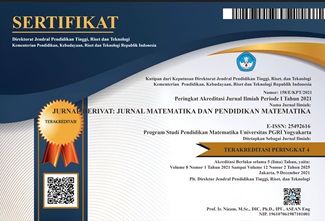Konsep Geometri Bangun Datar Pada Artefak Dan Relief Candi Plaosan
DOI:
https://doi.org/10.31316/jderivat.v10i3.5544Abstract
This research aims to explore the concept of geometry in mathematics in schools related to Plaosan Temple. This research was conducted at Plaosan Temple from January to July 2023. This research is descriptive qualitative research with an ethnographic approach. This research was carried out through observation, documentation and interviews to collect data. Observations were carried out directly at Plaosan Temple. Plaosan Temple is divided into two complexes, namely Plaosan Lor Temple and Plaosan Kidul Temple. Plaosan Temple is also nicknamed the twin temples. In the Plaosan Lor Temple complex there are several buildings including the main temple, Perwara Temple, Perwara Stupa, Mandhapa, Perwara Mandhapa Stupa, Fence, Kori Agung Gapura, and Dwarapala Statue. The informants in this research were cultural figures under the Central Java Cultural Heritage Preservation Center and junior high school mathematics teachers in Gunung Kidul. The data analysis technique in this research uses the Spradley model data analysis technique. The result of this research is the discovery of geometric concepts, especially flat-sided shapes in the Plaosan Lor Temple Complex, namely, triangle models, trapezoid quadrilaterals, rhombuses and parallelograms. From the geometric model of flat-sided spatial shapes, the concept of flat-sided spatial shapes was found in the artifacts and reliefs of Plaosan Temple
Keywords: Ethnomathematics, Mathematics Learning, Geometry, Flat Side Building
References
D’Ambrosio, U. D. (1985). Ethnomathematics and its Place in the History and Pedagogy of Mathematics. Sao Paulo: Editora Atica
Edward Burnett Tylor, (1871), Primitive Culture, London
Rachmawati, Inda. 2012. Eksplorasi Matematika Masyarakat Sidoarjo”. Dalam JURNAL UNESA. Vol 1,No (1).
Kahfi, M.S. 1996. “Geometri Sekolah Dasar dan Pengajarannya Satu Pola Berdasarkan Teori Piaget dan Teori Van Hiele”. Jurnal Ilmu Pendidikan. No. 4. 262-278. Malang: IKIP Malang
Putri, Linda Indiyarti . “Eksplorasi Etnomatematika KesenianRebana Sebagai Sumber Belajar Matematika pada Jenjang MI.” Jurnal Ilmiah Pendidikan Dasar IV, no. 1 (2017): 23-24.
Miles, M.B & Huberman A.M. 1984, Analisis Data Kualitatif. Terjemahan oleh Tjetjep Rohendi Rohidi. 1992. Jakarta : Penerbit Universitas Indonesia.
Hadari Nawawi dan Mimi Martini. 1991. Penelitian Terapan. Yogyakarta : Gajah Mada Press.
Russefendi, E.T. 1982. Metode Pendidikan Dalam Proses Belajar Mengajar. Jakarta: P3G Depdikbud.
Ruseffendi, E.T. (1988). Pengajaran Matematika Modern dan Masa Kini Untuk Guru dan SPG, Bandung : Tarsito.
Sarwono, J. 2006. Metode Penelitian Kuantitatif dan Kualitiatif. Graha Ilmu. Yogyakarta.
Sugiyono (2019). Metode Penelitian Kuantitatif, Kualitatif, dan R&D. Bandung : Alphabet.
Uloko, E.S. & Imoko, B. I. 2007. “Effects of ethnomathematics teaching approach and gender on students’ achievement in Locus.” Journal National Association Social Humanity Education. 5 (1): 31- 36..
Depdiknas .2003. Undang-undang RI No.20 tahun 2003.tentang sistem pendidikan nasional.
Van de Walle, J.A.. (1990). Elementary School Mathematics: Teaching Developmentally. New York: Longman.
Downloads
Published
Issue
Section
Citation Check
License
Copyright (c) 2023 Gunawan

This work is licensed under a Creative Commons Attribution-ShareAlike 4.0 International License.
Authors who publish with this journal agree to the following terms:
-
Authors retain copyright and grant the journal right of first publication with the work simultaneously licensed under a Creative Commons Attribution-ShareAlike 4.0 International License that allows others to share the work with an acknowledgment of the work's authorship and initial publication in this journal.
- Authors are able to enter into separate, additional contractual arrangements for the non-exclusive distribution of the journal's published version of the work (e.g., post it to an institutional repository or publish it in a book), with an acknowledgment of its initial publication in this journal.
- Authors are permitted and encouraged to post their work online (e.g., in institutional repositories or on their website) prior to and during the submission process, as it can lead to productive exchanges, as well as earlier and greater citation of published work (See The Effect of Open Access).







